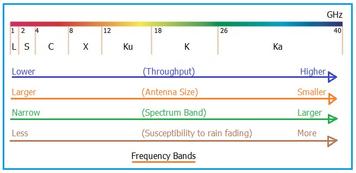Microwave Frequency: Advantages and Disadvantages
Advertisement
This page covers the advantages and disadvantages of microwave frequency. It mentions microwave frequency advantages or benefits and microwave frequency disadvantages or drawbacks.
What is Microwave Frequency?
Introduction: Figure 1 depicts the Electromagnetic Spectrum with frequency and wavelength.
Any frequency above 1 GHz is generally known as a microwave. It usually ranges from 300 MHz to 300 GHz on the scale. Microwave frequencies up to 100 GHz have been used in a wide variety of applications.

Following are the key features of Microwave frequencies:
- Large bandwidth
- Higher Gain
- High Directivity
- Travels in LOS (Line of Sight) mode
- Less noise in the 1 to 10 GHz band
Benefits or Advantages of Microwave Frequency
Following are the benefits or advantages of Microwave frequency:
-
Microwave frequencies can establish reliable wireless communication which can be used for information transmission. Hence cumbersome wired links can be avoided.
-
It has wider bandwidth and hence it can be used for the simultaneous transmission of voice, data, and video channels.
-
It has a short wavelength and hence antenna size is smaller and it is light in weight. Hence antennas are installed very easily on any wireless devices including mobile phones, tablets, laptops, aircraft, etc.
-
Miniaturized microwave components are available at affordable costs. Moreover, microwave towers do not require much area and hence telecom service providers can save in space/land as well as costs.
-
It can generate heat energy which is utilized in many bio-medical applications e.g., skin tightening, cancer treatment, etc. Moreover, it is used in microwave ovens for cooking food.
Drawbacks or Disadvantages of Microwave Frequency
Following are the disadvantages of Microwave frequency:
-
As it travels in line of sight, it is affected by obstacles such as mountains, tall buildings, etc. This has to be taken care of in RF budget planning.
-
The microwave frequencies are attenuated due to various parameters such as rain, snow, and fog, etc.
-
The microwave frequencies are reflected from flat & metal surfaces.
-
It is diffracted from solid objects.
Advertisement
 RF
RF


